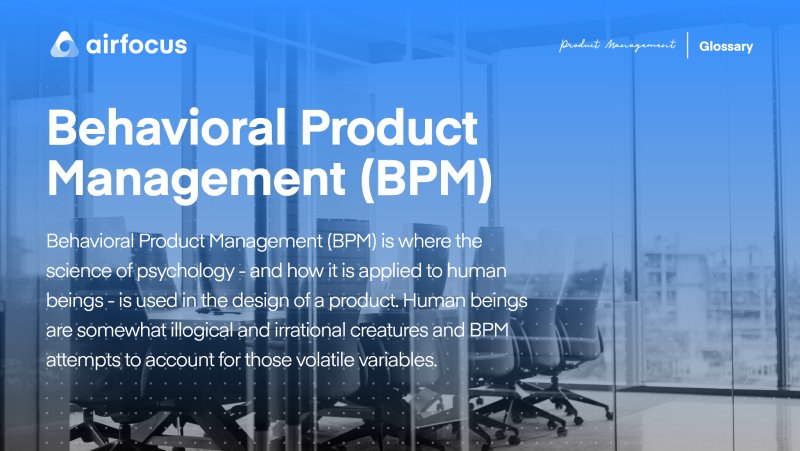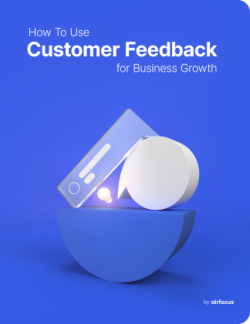Behavioral Product Management (BPM)
What is behavioral product management (BPM)?
Definition of behavioral product management (BPM)
Behavioral product management (BPM) is where the science of psychology - and how it is applied to human beings - is used in the design of a product. Human beings are somewhat illogical and irrational creatures and BPM attempts to account for those volatile variables. This works, in essence, in two ways. The design of a product can be heavily influenced by the psychology of the consumer, but also, psychology can be used to channel customers to certain behaviors that the product manager knows will benefit the product. In this fashion, the product and the consumer have a two-way relationship.
Designers in particular need to be aware of the emotions and experiences a consumer can go through when using a product. What makes the attention, what motivates them, and what keeps them motivated.
Why Use behavioral product management?
Regardless of whether or not a business consciously applies psychology to a project or the development of a product, it has to employ it to some degree in order to make it appealing to the consumer. An attractive product that performs well in the marketplace is always going to be a better prospect than one that performs well and is ugly. A product manager has to have at least some understanding of what moves consumers. Whether this develops into the formal application of psychology depends on a variety of factors.
BPM then, becomes an unavoidable expansion or offshoot of the more common product management process.
Through it, a Product Manager can gain great insight into the hopes, fears, frustrations, needs, and wants of the consumer. It is worth mentioning, however, that psychology and therefore BPM does not always successfully anticipate the way in which people act and react. Where research has been collated regarding a possible product and consumer views have been recorded in great detail, automatic predetermination of the creation of a successful product does not always follow. Attempting to quantify human volatility is an imperfect art at best.
The mechanisms of BPM
There are several ways in which Behavioral Product Management aids a product manager:
Spontaneous vs proactive Whereas casually employed psychology in product management is sporadic and unmeasured, actively applying BPM is much more proactive and systematic. A product manager will be able to create tools such as psychological performance indicators by which to hold the product accountable. By making aspects of the product development measurable to these indicators, a product manager will be able to map the path of the product and keep it attractive to the consumer.
Wielding human behavior concepts Existing known human behavior can be used when developing a product. Put very simply, if it were known that all consumers were attracted to the color green, it would benefit the product manager to make sure the product was green. Psychology provides understanding into how people think and designing a product that follows certain behavioral precepts will fare better in a competitive marketplace. This may even be the case when a consumer does not consciously realize they prefer a particular feature of a product even though the inclusion of the feature was deliberate.
Hunting for unique features A basic driving force behind the development of almost any product is to find a unique niche or specific feature that will give a business an edge in the market. To accomplish this an organization can harvest data from consumers regarding their yet-to-be-known behaviors and then attempt to meet these in the product. In contrast, an organization may choose to use previously entrenched expertise in a given subject area, and incorporate it into the product to influence the consumer.
Merging science and design As surely as other branches of science have progressed through time, so has psychology. Behavioral product management is not a new concept in itself, but it has been able to evolve alongside the scientific discipline of psychology, which has translated ultimately into the development of more and more sophisticated consumer products. The new car can take advantage of the invention of new polymers as they appear. BPM can equally take advantage of new psychological concepts as they are discovered. A host of industries have adopted a term that is used to describe the use of psychology in product development: “leveraging.”
Focusing on the consumer Behavioral product development is narrow in that it tends to concentrate exclusively on the end-user of the product. So perhaps in this way, it should be considered a branch of the wider product development and certainly not something that can replace it.
Instances of behavioral product management
Pricing The way in which a business prices a product can have a fundamental impact on consumer attitude. For example, when a product is highly-priced, it is easy to assume the immediate and more logical consequence will be to drive consumers away. This indeed does happen at least some of the time. However, a less intuitive reaction is one where consumers believe the value of the product must be higher because the price is. In turn, this can cause consumers to covet the product as an elite purchase.
Automation A well established psychological consumer trait is the dislike for having to repeat the same actions over and over. This is seen in the modern setting where consumers have to log into software applications each time they want to access them. The emergence of the automated login is appealing to consumers and its inclusion has made using any number of software products easier and more attractive to use.
Simplification Behavioral psychology indicates that human beings can feel swamped by an excess of choice. So, in an attempt to alleviate this, software applications have started to opt for slimming down what can be seen on-screen at any given time (mobile apps). By only including the most popular choices of the consumer on screen at any one time, the consumer has a more comfortable experience and is more satisfied with the product.

General FAQ

Glossary categories
All product feedback in one place

Experience the new way of doing product management








